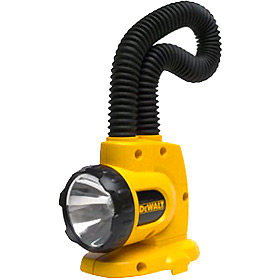About four years ago I got a set of 18V Dewalt cordless power tools. One of the tools was a gooseneck work light (DW919) that looks like this:
The light comes with a xenon incandescent bulb that puts out 325 lumens of light, and quite a bit of heat as well. I have used the light over the years when working in dark conditions, basements, attics, car repairs, and electrical work. More recently, my father-in-law was down to help me with some projects and one of those projects was reconfiguring some drainage lines in a crawlspace.
I brought out the Dewalt light for the project and about halfway through the day, the bulb burned out. We managed to finish up the project with the remaining light sources that we had available to us including cellphone lights. Speaking of which, I caught this picture of FIL expertly holding two sections of pipe at just the right angle to direct the unexpected flow of water from upstream.
We only got a little wet, and thankfully the drain wasn’t for a toilet.
Anyway, back on point, today I looked up the replacement light bulb and found it on Amazon for $8.25. It is a 2 pack, but given that the first bulb lasted for four years, I doubt I would still know where the other bulb was after all that time. I was interested to see what other alternatives were out there for replacements, especially in the LED area. I found one drop in replacement that was around $12, 3 watts, and 50,000 life hours, but it only put out a puny 100 lumens of light. That is less than a third (1/3) of the OEM incandescent bulb. I wanted something brighter, so I kept looking and eventually I found the Fusion 48 LED replacement at a whopping 1600 lumens.
The LED array is expensive at $36. That is not too far off from the price of the bare tool itself. Still, the reported benefits seem worth the risk of trying it out. For starters, the claimed lumen output is almost 5x greater than the OEM bulb. LEDs are more efficient at converting electricity into light and they generate less heat waste, so the reported runtime on a battery is claimed to be twice as long. Finally, the life hours is claimed to be a whopping 20,000 hours. Take that all together and you end up with a super flashlight that is the equivalent of having five normal lights, while lasting twice as long per battery, and most likely outliving the tool itself.
It seemed that other DIY’ers had success with this particular replacement, and one person wrote up a nice bit about it on this forum. I’ll do an update if it ends up being a turd, but for an up charge of $28, it seems like a decent risk to try it out.


